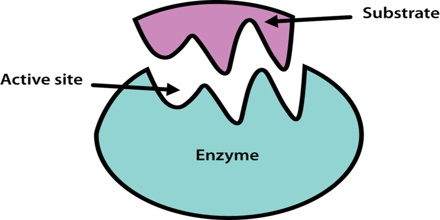
What is the molecule on which an enzyme acts?
Answer
455.1k+ views
Hint: Enzymes are proteins that act as the catalyst in our bodies. These proteins are responsible for setting off physiological reactions in the body. For example, amylase is the enzyme that binds to certain molecules in starch and breaks it down.
Complete answer:
The molecule that the enzyme binds to is known as a substrate. The enzyme and the substrate fit together like jigsaw puzzle pieces. Thus when it is time for the substrate to be broken down, the enzyme gets released. The enzyme must fit into the active site of the substrate in order to set off the reaction.
For example, when we eat food that contains starch, our mouth starts to salivate. The saliva that we hold contains amylase which is an enzyme that breaks down starch. When the amylase is released, it is attached to the starch molecule and breaks it down into simpler molecules which can then be used to produce energy.
If the shape of this substratum is changed in some way then the enzyme cannot bind to it. Thus the enzyme isn’t able to work and gets inhibited. This is how the action of enzymes gets inhibited.

Note:
Enzymes bind to substrates in order to set off their reactions. In order for an enzyme to work, it must bind to the active site of the enzyme. If another molecule binds to the substrate and changes its conformation it will inhibit the enzyme and thus the process will not work.
Complete answer:
The molecule that the enzyme binds to is known as a substrate. The enzyme and the substrate fit together like jigsaw puzzle pieces. Thus when it is time for the substrate to be broken down, the enzyme gets released. The enzyme must fit into the active site of the substrate in order to set off the reaction.
For example, when we eat food that contains starch, our mouth starts to salivate. The saliva that we hold contains amylase which is an enzyme that breaks down starch. When the amylase is released, it is attached to the starch molecule and breaks it down into simpler molecules which can then be used to produce energy.
If the shape of this substratum is changed in some way then the enzyme cannot bind to it. Thus the enzyme isn’t able to work and gets inhibited. This is how the action of enzymes gets inhibited.

Note:
Enzymes bind to substrates in order to set off their reactions. In order for an enzyme to work, it must bind to the active site of the enzyme. If another molecule binds to the substrate and changes its conformation it will inhibit the enzyme and thus the process will not work.
Latest Vedantu courses for you
Grade 10 | MAHARASHTRABOARD | SCHOOL | English
Vedantu 10 Maharashtra Pro Lite (2025-26)
School Full course for MAHARASHTRABOARD students
₹33,300 per year
Recently Updated Pages
Master Class 11 Accountancy: Engaging Questions & Answers for Success

Master Class 11 Physics: Engaging Questions & Answers for Success

Master Class 11 Business Studies: Engaging Questions & Answers for Success

Master Class 11 Maths: Engaging Questions & Answers for Success

Master Class 11 Chemistry: Engaging Questions & Answers for Success

Master Class 12 Biology: Engaging Questions & Answers for Success

Trending doubts
Which one is a true fish A Jellyfish B Starfish C Dogfish class 11 biology CBSE

Difference Between Prokaryotic Cells and Eukaryotic Cells

1 ton equals to A 100 kg B 1000 kg C 10 kg D 10000 class 11 physics CBSE

1 Quintal is equal to a 110 kg b 10 kg c 100kg d 1000 class 11 physics CBSE

One Metric ton is equal to kg A 10000 B 1000 C 100 class 11 physics CBSE

How much is 23 kg in pounds class 11 chemistry CBSE




